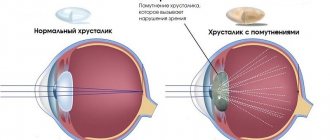Blepharitis in a dog
Blepharitis is a disease characterized by inflammation of the eyelids. In most cases, blepharitis in dogs is caused by allergic or autoimmune reactions and is a fairly frequently diagnosed disease. Also, this disease is related to ophthalmologists and dermatologists, and therefore may sometimes require examination by both specialists.
Symptoms of blepharitis in dogs
Blepharitis in a dog
The symptom complex may include redness and swelling of the eyelids, often with itching, alopecia, various types of discharge (ichor, mucus, pus). With blepharitis, single or multiple abscesses can form on the eyelids and conjunctiva, and the meibomian glands can become clogged, overflowing with fatty secretions. A dog with blepharitis may squint and not open its eyes, and the edges of the eyelids may become pink (depigmented).
With long-term chronic blepharitis in dogs, blockage of the meibomian glands and the formation of a chalazion (popular name - barley) can develop.
Types of disease
Blepharitis is classified according to several criteria.
Based on the localization of the inflammatory process, we can distinguish:
- Anterior edge - when only the ciliary edge of the eyelid is involved in the painful process.
- Posterior marginal is said to occur when the meibomian glands and surrounding tissues are inflamed.
- Angular or angular - indicates the localization of inflammation mainly in the corners of the eyes.
- Mixed involves all the tissues of the eye, as well as the skin and surrounding muscles.
Based on the characteristics of clinical signs, the following forms of the disease are distinguished:
- Simple. It has mild symptoms - moderate redness of the dog's eyelids, thickened edges, whitish secretion in the corners of the eye.
- Scaly. The edges of the eyelids are thicker. It can be recognized by the characteristic scales of the epidermis, which are located at the base of the eyelashes.
- Ulcerative. This is a purulent form of the disease. Crusts of dried pus on the eyelids form painful ulcers after removal. Inflammation is accompanied by loss of eyelashes, severe itching and pain. After the ulcerations heal, scars form on the eyelids, interfering with the normal growth of eyelashes.
- Meibomian. It occurs as a consequence of hyperfunction of the meibomian glands. Excess secretion becomes a breeding ground for the development of pathogenic microflora. The disease can be complicated by a purulent course.
- Furunculous or phlegmous also has a name - barley. The most characteristic signs are the appearance of one or more abscesses along the edge of the eyelids, on the eyelash line, which open over time. This is the most dangerous type of disease, as it can have a dangerous life-threatening complication - sepsis.
Causes of blepharitis in dogs
The most common causes of blepharitis include congenital/hereditary abnormalities, allergic and autoimmune reactions, infections, parasitic infestations, and tumor processes.
Congenital and/or hereditary diseases, such as underdevelopment of the eyelids, entropion of the eyelids (entropion), inversion of the eyelids (ectropion), pathological eyelashes, excessive folding (especially among brachycephalics (pugs, Pekingese, Persian cats), some Shar Peis) can cause secondary inflammation century
Allergic blepharitis can often occur against the background of food allergies, reactions to environmental components (atopy), or to flea saliva. Contamination with secondary microflora and self-traumatization (with itching) can provoke the appearance of abscesses and further deterioration of the condition. Moreover, with serious contamination with microorganisms (especially staphylococcus spp.), sensitization and an even more acute inflammatory reaction can occur. Fungal infections can also cause serious blepharitis, but this is very rare in St. Petersburg (and other cold regions of Russia).
Parasitic blepharitis in dogs most often occurs against the background of demodicosis and sarcoptic mange.
There is also a large group of immune-mediated blepharitis, which occurs due to improper functioning of the dog’s immune system. These include, for example, juvenile pyodermatitis, uveodermatological syndrome and other diseases.
Main symptoms
Each type of blepharitis has its own set of characteristic symptoms. But there are signs that are inherent in any form of the disease. These include the following:
- swelling and redness of the eyelids;
- severe itching and burning;
- photophobia;
- lacrimation;
- thickening of the diseased eyelid.
Sometimes these symptoms are accompanied by so-called blepharospasm. This is a reflex spasm or painful tension in the muscles surrounding the inflamed eye.
Purulent and ulcerative blepharitis is characterized by discharge with purulent contents and accumulation of purulent exudate in the corners of the eyes.
Diagnosis of blepharitis in dogs
There are many causes of blepharitis. Therefore, diagnosing blepharitis may take some time. During an ophthalmological examination, it is necessary to exclude ocular causes for this disease, therefore it is recommended to conduct a Schirmer test, a fluorescein test, and biomicroscopy. Additional studies may include scraping for parasites, cytological examination, and bacterial culture. If the cause of inflammation is a neoplasm, histological examination may also be required.
Since blepharitis can be the result of a systemic disease, a general examination and blood test of the dog will allow us to better understand the cause and provide better care.
What are the recovery forecasts?
Common types of blepharitis (simple, scaly, ulcerative, purulent) are successfully treated with local antibacterial and anti-inflammatory drugs. If the disease was caused by a congenital defect of the eyelid, a simple surgical operation is performed, after which a rapid recovery occurs.
Phlegmonous blepharitis can become chronic. If the cause of the disease is an allergy, contact of the pet with the allergen should be excluded, otherwise recovery may not occur.
Blepharitis is a disease that affects your pet's eyelids. It is not transmitted to humans or pets, but it causes discomfort to the dog. If you notice that your pet's eyelid is swollen, red and crusty, contact a veterinary clinic.
Treatment of blepharitis in dogs
Treatment of blepharitis (a set of drugs, duration and intensity of courses), as well as the prognosis for recovery, depend entirely on the cause of the disease. If the disease is caused by entropion, the dog will benefit from eyelid surgery. If parasites – appropriate antiparasitic and antibiotic therapy. If there is an allergic/autoimmune reaction, a course of anti-inflammatory drugs (SPVS, NSAIDs). This is a great difficulty in treatment, because the treatment of different blepharitis is absolutely the opposite! For example, anti-inflammatory therapy can seriously harm parasitic infestations.
Treatment of blepharitis at home and first aid for a dog
Help for a sick dog is provided according to the following scheme:
- Getting rid of purulent crusts.
- Relief of the inflammatory process.
- Destruction of pathogenic microorganisms.
All forms of this pathology can be cured with the help of local medications.
- Purulent crusts and scabs formed on the edges of the eyelids are moistened with water and carefully removed. To enhance the effect, it is recommended to moisten a cotton swab with furatsilin or saline solution. Then the tampon is applied to the sore eyelid. The crusts are removed using a bandage or sterile gauze.
- The inflammatory process is stopped with Dexamethasone or Hydrocortisone. These ointments are used as prescribed by a doctor.
- Bacteria and other pathogenic microbes are destroyed using erythromycin or tetracycline ointment. The drug is applied to the affected eyelid no more than 3 times/24 hours.
Using a furatsilin solution, purulent crusts are removed.
These ointments can be combined and alternated with calendula infusion, as well as syntomycin and gentamicin ointments. These funds are applied to the affected eyelid. Then the animal’s sore eye must be gently massaged for 5 minutes.
Help with staphylococcal form
If the root cause was staphylococcus, then therapy is prescribed taking into account the dog’s hypersensitivity to a particular drug. It is recommended to daily lubricate the edges of the eyelids with a 1% solution of brilliant green.
For the staphylococcal form, a solution of brilliant green is used.
Help with ulcers
It is necessary to treat the crusts daily with Vaseline oil. It has a soft, gentle effect. After greasing, you need to wait 2-3 minutes, and then carefully separate the crusts.
The edges of the affected eyelid are treated with xeroform or ichthyol ointment. But daily cauterizations are also recommended, but this must be done by a veterinarian.
Ichthyol ointment is used to treat affected eyelids.
Other treatment methods
Surgery is prescribed when the root cause of blepharitis is a tumor.
Before surgery, the nature of the tumor must be determined. If it was malignant, additional treatment is prescribed.
If blepharitis was caused by microscopic mites, then the doctor prescribes the use of Metronidazole gel. The edges of the diseased eyelid should be treated with this product daily.
Metronidazole gel is prescribed if the cause of the disease is microscopic mites.
Course of the disease
The course of the disease can be constant and unexpressed or acute and requiring immediate intervention.
In the first scenario, if, moreover, blepharitis cannot be completely cured, maximum relief of its manifestations will be justified in order to prevent the consequences of the influence of the inflamed eyelid on the surrounding tissues.
In case of acute blepharitis, accompanied by a considerable number of unpleasant manifestations for the dog, immediate treatment is required. Typically, acute blepharitis does not have a chronic course and responds well to proper treatment.
Main types of pathology
The disease has several types.
Blepharitis can be:
- scaly;
- ulcerative;
- meibomian;
- furunculous.
Features of the scaly shape
The animal's eyelids become very red. Epidermal scabs appear at the base of the eyelashes. They have a whitish-gray tint. In parallel, conjunctivitis develops.
With the scaly form, the dog simultaneously develops conjunctivitis.
Features of the ulcerative form
The dog's eyelids swell slightly. Purulent crusts form on them, masking a bleeding ulcerative cavity. Loss of the affected hair follicles of the eyelashes is observed.
The edges of the eyelids are rolled up and smoothed out. The dog suffers from itching and excessive lacrimation.
The ulcerative form is expressed by severe itching around the eyes.
Features of the meibomian form
The secretion of the meibomian glands penetrates the conjunctival cavity. An inflammatory process develops there. The edges of the animal's eyelids become thicker. Later, purulent inflammation develops.
In the meibomian form, inflammation of the eyelids occurs.
Features of the furunculous form
The cause is mechanical damage to the eyelid. The dog may hit the eye or scratch it vigorously.
A furunculous form can form if a dog scratches its eye excessively.
This form of blepharitis is characterized by the discharge of pus from the glands.
Prevention of blepharitis
It should be remembered that the manifestation of blepharitis can be a symptom of an internal disease, therefore, to prevent it, it is very important to monitor the dog’s health and carry out timely diagnosis in the clinic.
A great way to prevent inflammation of the eyelids is to follow the rules of a healthy lifestyle for dogs as much as possible. A nutritious and balanced diet, a regimen of rest and walks, vitamins and fresh air will help restore and maintain the dog’s strength.
Also, prevention will require proper adherence to hygiene standards for keeping a pet, especially in places where it spends a lot of time, sleeps and plays.
What is blepharitis
In essence, the disease is a pathological process localized along the edges of the eyelids. The causes of blepharitis can be very different, related to chemical, thermal exposure or eye injuries.
A parasitic mite that causes demodicosis or scabies can also provoke pathology. In addition, inflammation in this area may be the result of vitamin deficiency, a previous microbial or viral disease.
General characteristics of the disease
Blepharitis is an inflammatory disease of the eyelids, which is most often localized on their outer side. The eyelid thickens and swells; with severe swelling, it turns out. The animal experiences severe itching and pain in the eyes. Often the conjunctiva is also included in this process.
Quite quickly, without proper treatment, pathology becomes aggravated by complications in one form or another.
Symptoms of the disease
The first symptoms of the disease are often ignored by dog owners, as they consider them signs of conjunctivitis or the result of irritation of the eye by a foreign object.
The initial manifestations of dry eye syndrome include:
- redness of the conjunctival membrane;
- swelling of the conjunctiva;
- periodic purulent discharge from the eye;
- profuse lacrimation.
It is quite difficult to suspect dry eye syndrome in a dog based on such symptoms, since they are similar to the manifestations of other eye diseases, and lacrimation confuses not only the owners, but also inexperienced veterinarians.
Later, the health condition worsens, and dry eye syndrome in a dog at this stage has the following symptoms:
- copious purulent discharge from the eyes, which looks like mucous threads sticking together the eyelids;
- cloudiness of the cornea;
- blepharospasm;
- corneal ulceration;
- development of vascular or pigmentary keratitis.
In order not to bring the disease to a critical point, it is better to contact a veterinarian, even if your pet’s eyes are simply red or purulent crusts appear in the corners.
What actions should owners take if their dog gets blepharitis?
Naturally, at the slightest suspicion of problems with the animal’s visual organs, especially if it is already of advanced age and has a number of internal diseases, you need to take it to the veterinarian and not self-medicate.
The veterinarian will diagnose the animal and prescribe a course of medications, which must be strictly adhered to.
To prevent the animal from scratching the already inflamed eyelids with its claws, leading to an even greater spread of the infection, you will need to put a specially configured cardboard collar on the dog so that it does not interfere with eating and drinking, but also prevents the dog from scratching the affected area.
In addition to the prescribed treatment, you can wash the dog’s eyelids with a warm infusion of disinfectant herbs to cleanse dried pus and crusts.
Owners should not forget that with this disease the dog must adhere to a strict diet, since harmful foods can cause an exacerbation of symptoms.










